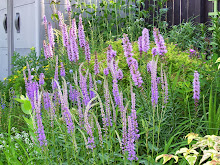 |
| It will another two months before my front yard looks like this. |
Beth Chatto's garden in the UK came up on my FaceBook page this morning and I can't help but be a tad jealous. All those spring ephemerals blooming their buds off. (Of course, in traditional English fashion there were comments about the poor weather.)
What do I have to show spring is here? The remnant of the daylilies are easy to pull from their crowns as are those of the lily of the valley, both sure signs that something is happening underground.
What really makes flowers pop is rain. There is more than a bit of truth in the adage, "April showers bring May flowers." Here in the central part of Wisconsin we have had little precipitation through the winter and this spring. Anyone in California, I feel your pain, but I am sure not the depths of your despair. Water is still as close as the faucet here in Wisconsin where we still have vast reserves in our underground aquifers and an artesian spring bubbling by the brook north of the village.
As you grow as a gardener, you come around to having something blooming in all seasons. I have always felt here in central Wisconsin we are limited in our choices. I am envious of gardeners in other parts of the state where snowdrops and hellebores can herald spring. I am not quite sure witch hazel could make a stand here either. I have never seen any growing locally. With our deer population, even many native ephemerals have a hard time of it.
The limited range of spring ephemerals comes down to ginger (which is almost a non-contender harboring its flower under its low leaves), hepatica, bloodroot, trillium, daffodils, crocus, sweet woodruff, and Virginia bluebells-- hardly the show for a gardener to strive.
 |
| A bergenia shown with its "cold coloration". I moved a healthy clump to the edge of the sidewalk last fall. It is the only color in my front yard other than brown. |
Here we should be relying more on our cornus and low growing evergreen plants to provide us color. Even sedum with their nubile buds peeking up from the debris collected over the winter around their crowns can provide some bits of green.
Which is why is so irks me I cannot identify an evergreen outside of the conifer groups to provide some sort of broad leaf and the burn on the boxwood burns me.







Sorry about your boxwood. But that list of spring flowers you can grow sounds pretty nice to me. What about Scilla?
ReplyDelete